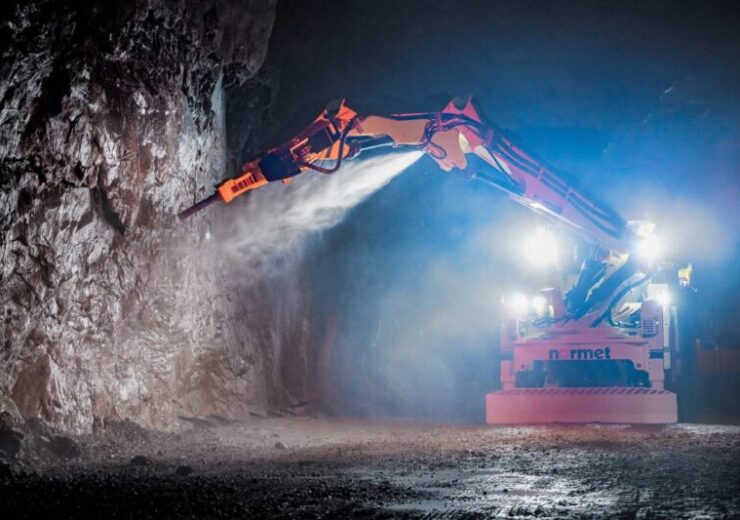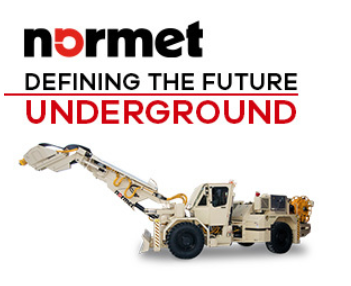The mining industry has been seen as notoriously slow when it comes to adopting the latest technology. As the sector is cyclical, companies have been hesitant to implement large changes, but trends indicate that this may be shifting.

Underground scaling operations. (Credit: Normet)
As per the Mine-Site Technology Adoption Survey, 2022 Update analysis by GlobalData, 39% of mines are likely to invest in battery electric vehicles (BEVs) in the next two years, as opposed to just 23% in the Q4 survey in 2020.
Increased interest in battery electric vehicles
So, what’s driving this increase in interest in battery electric vehicles? Decarbonisation is a clear aspect, with sustainability becoming an issue that is affecting the world at large. There are other areas of growing investment in mining technologies, including management software, collision prevention, fatigue detection, and predictive maintenance. These suggest that mines are more likely to use technology for security and to increase productivity.
Diesel vehicles account for 30-50% of all greenhouse gases at mine sites and replacing them with batteries-powered vehicles can significantly reduce overall CO2 emissions. But what are the other benefits to mines from the new technology?
Normet, a leading underground manufacturer, believes that the solution lies in the SmartDrive architecture for battery electric vehicles. SmartDrive was designed with the help of customers, using feedback to predict future trends, and analysing the limitations that diesel engines have. It has a variety of benefits for operators.
Fire hazards in mining are substantially brought down
Normet Group equipment offering and new technology vice president Mark Ryan said: “Looking at underground fire statistics, there’s a paper written by the University of Queensland in 2018. It highlighted the main causes of fires underground, and 46 of 80 cases were caused by the diesel engine due to the huge amount of heat that they generate.”
The heat is generated by turbochargers and exhaust manifolds, which are removed with battery-electric technology. Furthermore, SmartDrive eliminates the necessity for fuel load, which could typically hold up to 300 litres of fuel. In the end, this greatly reduces the chances of fire incidents.
Reduced CO2 and a work environment that is safer
Ryan said: “We talk a lot about CO2 and the environment. But underground, people often forget about diesel particulate matter and how harmful that is to people.”
The International Agency for Research on Cancer (IARC) has classified the exhaust of diesel engines as carcinogenic to humans due to the fact that there is sufficient evidence that it’s linked to an increased chance of developing lung cancer.
The World Health Organisation has cautioned people residing in areas with a high population that exhausts from diesel engines are associated with a lower life expectancy above ground. The enclosed areas in the underground pose much significant risk. The replacement of diesel engines with SmartDrive BEV vehicles helps eliminate dangerous fumes, and dramatically improves the quality of air in underground operations.
How less ventilation can drive savings in money and energy
In order to ensure that the air is as clean as possible, mines put huge sums of money into the ventilation systems’ infrastructure as well as the energy needed to operate them. Battery electric vehicles mean that significantly less ventilation is needed to ensure lower temperatures and cleaner air.
Ryan said: “The millions of dollars that they need to spend on creating exhaust shafts is dramatically changed.
“We’re often asked if it is a lost cause for customers that are currently running diesel to switch to BEV. I would say no, because usually the trend is that our customers are going deeper.
“If they decide to adopt BEV equipment such as SmartDrive, as they go deeper, they will still see the benefits with regards to the ventilation requirements. In some cases, we’re already seeing that because they can save money on infrastructure, energy, ventilation, and operations that we once considered to be too expensive become viable again.”
Bringing down noise pollution by 80%
Reduced noise that comes from heavy vehicles can have a variety of benefits, specifically for tunnelling in populated regions where there could be restrictions on noise. A more peaceful work environment is also a benefit for underground workers.
Ryan said: “With SmartDrive, we’re seeing 80% less noise and 55% less vibration compared to a diesel equivalent.
“We all understand that body vibration can cause fatigue and headaches, and when you have very tired people, you have the potential for accidents. It’s the same with noise; if you’re exposed to very high noise levels every day, it can have long-term effects on your health.”
When it comes to lesser temperatures and better air quality along with less noise and vibration, Ryan says that the difference can’t be seen until the two environments have been experienced. This makes it a completely different work experience.
Why smart technology increases efficiency and needs less maintenance
Ryan explains: “Electric motors are pretty much maintenance-free.
“The components that make the machine move are far simpler than the diesel equivalent, so we’re seeing a lot of opportunities with regards to cost per hour benefits. Additionally, if we compare diesel to electric, we see an increase in ramp speeds and cycle times.”
SmartDrive technology boasts of increasing the uphill tramming speed by more than 100%, while offering rapid acceleration, and driving as much as 25% faster cycles, along with quick charging capabilities and up to 50% power recovery for downhill driving.
More miners seek a supply chain that is sustainable
Ryan said: “We’re enabling and helping our customers to potentially be able to achieve their CO2 targets. It’s becoming more of a trend for people to want minerals to be produced in a sustainable way, and we see that we’re very much part of that discussion, which we are very excited about.”

